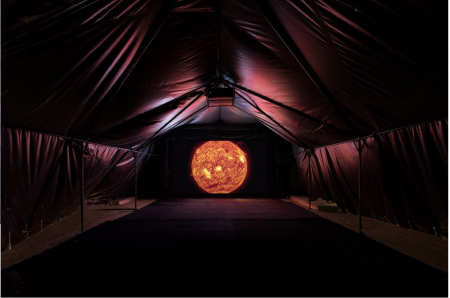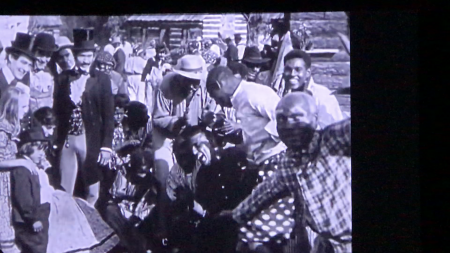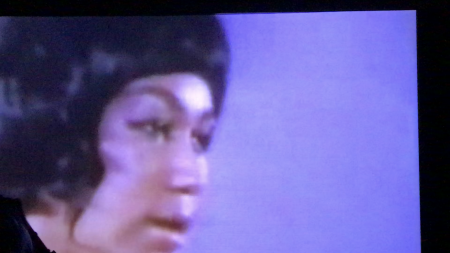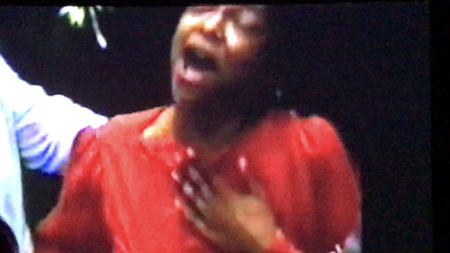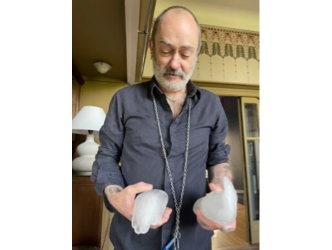The short extracts which could be available to watch online give nothing away compared to the powerful impact of seeing it on the big screen, immersed in the accompanying music by Kanye West.
(It’s very frustrating but all the video extracts that I filmed in the screening room have been censured by YouTube on account of copyright infringement.)
On show now until 10 December, the work is presented by the Serpentine Gallery in London but is being screened by the Vinyl Factory (at 180 The Strand) and also in Washington at Hirshorn.
The film was exhibited this summer at the Met Breuer in New York and in Arles ( South of France) at Maja Hoffmann’s Luma foundation, as well as at London’s Serpentine Gallery, Los Angeles’s Moca and Detroit’s Museum of Contemporary Art.
Arthur Jafa’s subject is simple and the way in which he approaches it is innovative. His subject is the black experience in the United States and, as he clearly states, he wants to speak directly to black Americans.
“We are illegitimate products of the West,” he says frankly, “We are descendants of Africans. We are bastards. In a society where one either takes the position of object or of subject, we are in between the two, situated between the classical object and the classical subject.”
He talks about how there was a time when he wanted to abandon the visual arts in a hostile art world, and it was in Los Angeles that his friend Kahlil Joseph, a famous music video director, persuaded him otherwise, urging him not to put the film on YouTube.
Nevertheless Arthur Jafa confirms that he will make it available online soon. (As a side note, the work of Kahlil Joseph is on show right now at the New Museum in New York. And incidentally he is also the brother of Noah Davis who had the idea for the legendary Underground Museum in Los Angeles.
Since then Arthur Jafa has gone on to sell his artworks to big institutions, such as the Met in New York in 2017.
He is exhibited by the New York gallerist Gavin Brown, who screened one of his earlier videos at Art Basel last June as part of the Art Unlimited showcase, and gave him a substantial space at his booth at the last Frieze art fair in London with self-portraits and flat images arranged like advertising placards around the space.
But the true measure of Arthur Jafa’s mastery is in the cadence he brings to the unity of sound and image.
The university professor Tina M Campt recalls how (1): “When I met Arthur Jafa for the first time in autumn 2016, we discovered that we share a common obsession: a deep and abiding investment in the vibration, frequency and sonic tonality of images.
“Black cinema with the power, beauty and alienation of black music (…) That insistent question – how to develop the sonic and musical intonation of film with the cinematic capacity to fully render the black experience – is one that Jafa pursues in his artistic practice as a quest to capture the visual frequency of Black life.”
Arthur Jafa eloquently explained to me how during the past enslavement of the black population of the United States, it is music alone that has been able to occupy a privileged space, unlike other disciplines such as, for example, architecture or painting, and that going forward this aesthetic must be updated.
He says that his work is aimed at black people.
This is because “generally, 99% of ideas are developed by white men.
Consequently, they haven’t had to use their ability to put themselves in another person’s skin.
It’s like when Eric Clapton wrote Layla. It’s addressed to just one woman, but other people can still listen to it. And in my case, I’m addressing black people.”
He explains:
Lastly, I ask him if he sees the art world becoming more open to the creations of black Americans.
This is his response:
We should watch Arthur Jafa’s work because he carries with him a new kind of aesthetic, one which pushes the viewer to a certain level of elation.
We should listen to Arthur Jafa because he carries with him words that are radical, and necessary.
“I’m tryna keep my faith / We on ultralight beam / we on a ultralight beam / This is a God dream / this is everything… / Im tryna keep my faith / But Im looking for more / Somewhere I can feel safe / and end my holy war / Im tryna keep my faith.”
Kanya West “Ultralight Beam” audio spine for Arthur Jafa’s “Love is the message, the message is death”. (2016).
-Until 10 December.www.serpentinegalleries.org/exhibitions-events/arthur-jafa-love-message-message-death.
-Until 22 April. hirshhorn.si.edu/exhibitions/message-new-media-works.
-The London exhibition will travel to the Julia Stoschek Collection, Berlin in February 2018 until November.
www.julia-stochek-collection.net
Donating=Supporting

Support independent news on art.
Your contribution : Make a monthly commitment to support JBH Reports or a one off contribution as and when you feel like it. Choose the option that suits you best.
Need to cancel a recurring donation? Please go here.
The donation is considered to be a subscription for a fee set by the donor and for a duration also set by the donor.


